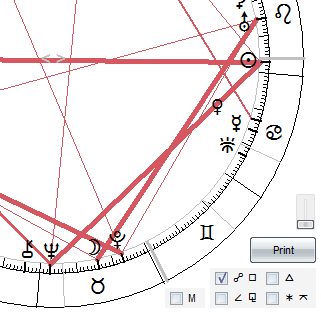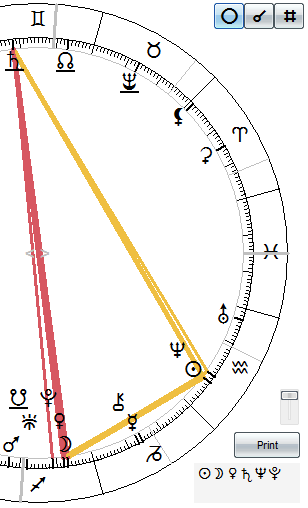
| What Watch? - Tutorial | Next chapter: Dignities | Back to First Page |
Aspects
What Watch offers two different ways of dealing with aspects: classical aspect lines and a "harmonic aspectarian" which is a unique feature of What Watch.
 |
In the first method, aspect lines connect all planets in a chart that form an aspect between them. There are lots of them in every chart, especially if you use big orbs. The sheer number of aspects points to the limit of this method: it's often hard to discern patterns in the overwhelming chaos. This is why What Watch lets you select and deselect groups of aspects so you can choose only those you'd like to analyze in depth to show up in the chart wheel. Exact aspects will display as a bold line, and the wider the orb, the thinner the line will be. Aspect lines to minor planets are only displayed if you check the "M" switch, to enhance readability of the chart. |
You can also display aspects individually for each planet. In the chart, click on a planet: all aspects of this planet are now shown in the chart.
Another alternative is to show aspects only of selected planets. To use this method, please slide the switch above the print button upwards and click in the wheel on those planets whose aspects you want to see. The corresponding aspect lines will be shown automatically.
The maximum orb to show for each aspect group can be changed on the preferences tab.
The Aspectarian
The second method, the "harmonic aspectarian", puts
its emphasis on a display method derived from working with harmonic charts.
Let me explain it in some detail: it's based on the fact that aspects are
mostly derived by dividing the 360 degree circle by a given number. If you
divide 360 by 2, you get 180 or an opposition. Dividing by 4, or two times
2, you get 90 or a square. Two times two times 2 means dividing by 8 obtaining
45: a semisquare.
If you divide a chart circle by 8 and draw the resulting positions on one 45 degree line, you obtain what is called the 8th harmonic. This is what you see in the first row of the harmonic aspectarian. (Other software draws harmonic charts in wheels, not on lines. Basically, it's the same method. I think drawing on a line is sufficient here, using less space.)

All planets being close together in this row are in one of the following aspects: conjunction, opposition, square, semisquare or sesquiquadrate. Except for the conjunction, that shows up alike in all harmonics, all these aspects are an expression of the principle of Twoness. In his classic work on harmonics, David Hamblin associates this principle with "striving": These energies do not fit neatly, you have to work to bring them together. As this is necessary for one's psychological development, one is "striving" to reconcile these energies.
 |
Let's have a closer look at the example shown above. As you can easily see, the following planets are in close aspect: Sun, Moon, Venus and Saturn. Switch back to the natal wheel, and you'll find the following pattern (see left): Moon and Venus are in conjunction, opposition Saturn and semisquare the Sun. Neptune is about two degrees away, Pluto about three. Even when using small orbs, both are to be considered part of the pattern. So, with one glance at the "striving" row of the harmonic aspectarian, quite a complex pattern involving six planets can be easily spotted. Other than Two
The next two rows show the principle of Threeness. One shows trines, the other three times 3: the 9th harmonic. The latter is traditionally used in Indian astrology and represents pleasure, enjoyment and harmony. |
The last two rows display information on Fiveness and Sevenness. Five is the principle of mankind as a builder in this world. Energies linked by Fiveness allow to give form, to give one's imprint on the material world. Seven is a glimpse of the divine, showing what might be possible without the restraints of the world as it is, thus giving inspiration and hope.
Literature:
Karen Hamaker-Zondag - Aspects and Personality, Weiser, York Beach ME 1990
David Hamblin - Harmonic Charts, Aquarian Press, Wellingborough (UK) 1987 (out of print)
Michael Harding, Charles Harvey - Working With Astrology, Penguin (Arkana), London 1990
| What Watch? - Tutorial | Next chapter: Dignities | Back to First Page |